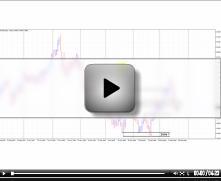Relative Strength Index (RSI) strategy
Hi, this is Ty Young with Surefire-trading.com and today I will be discussing the Relative Strength Index (RSI).
History
J. Welles Wilder, Jr., a contemporary technical analyst, is well noted for his accomplishments as the designer of several technical indicators. Though the simplest of these to understand is the RSI oscillator, it is hardly the least in importance to the committed trader. In fact, next to the Bollinger Bands, this is a tool that I reach for most often. Though Wilder’s indicators were intended to function as “stand-alone” systems, I find greater confidence in using them as confirmation triggers. I never place my complete trust in any single indicator.

Technical
Wilder describes the RSI, along with his other indicators, in his book, “New Concepts in Technical Systems”.
The RSI is quite simple in its construction, calculated as follows:
100
RSI = 100 - ___________________________
1+ (Average Gain / Average Loss)
However, every major charting service I have viewed calculates the formula for us.
Primarily, the RSI measures the internal strength (by comparing the current price against the average price - thus the term “Relative Strength”) of any given security (or in our case, currency) providing awareness to overbought (OB) and oversold (OS) conditions, as depicted on a scale of 0 – 100.
Generally, the rule of thumb is - when price rises above an RSI level of 70, it is considered to be OB; and below 30 is considered OS. Now, this is not to say that when the RSI rises above 70 that it is time to sell; nor, is it time to buy when it drops below 30 since markets can remain in OB/OS conditions for extended periods of time.
Also, because the RSI often leaves OB/OS territory and immediately crosses back into those levels, we want to exercise extreme caution when trading such signals.
In addition to the 30 and 70 RSI levels, the 50 RSI level is equally vital to interpreting the chart. Above the 50-line is generally considered bullish, whereas, below the 50-line is generally considered bearish.
Also, remember, the RSI is a lagging indicator; in other words, it follows the price (the price moves, then the indicator follows – it is NOT predictive). Despite popular opinion, we are not ‘fortunetellers” and there is NO crystal ball; so we must use other means to trigger our entries.
In the last lesson entitled “Bollinger Bands”, we briefly made mention of two methods of using the RSI as confirmation. Let’s delve into these a bit deeper. One of the most ideal ways is to look for divergence; the price rises to a new high, whereas, the RSI fails to break its previous high (bearish). Conversely, when price makes a new low, subsequently, the RSI fails to break its previous low (bullish). Divergence provides us with a signal that may lead to a reversal or merely a correction (be it ever so slight); also known as a retracement.
Another method is a RSI trend line break that corresponds to a trend line break (and subsequent close) on the price chart.
And the RSI can also be used for a “breakout” strategy, as well.
So, let’s take a look at some examples.
Charts
In using the RSI as a signal for OB/OS conditions, one practice, which is often taught among traders, is to watch for the RSI to cross into OB/OS territory. Once the RSI moves out of OB/OS territory, we have an opportunity for a possible entry. If done correctly, this method can be profitable – however, it can be a very dangerous means of trading if acted upon too presumptuously. And here’s why.
As we look between the two vertical red lines on the 60-min. Euro chart below, we see that the price moved from a low of 1.5254 to a high of 1.5421 – a rise of 167 pips, while the RSI continued to whipsaw numerous times across the 70-line and back again. Had we entered a short position when the RSI initially crossed above the 70-line, we would have unnecessarily placed ourselves in harms way; likewise, had we taken a position immediately following the subsequent cross below the 70-line (believing the bullish move to be completed), the results would have been equally devastating.
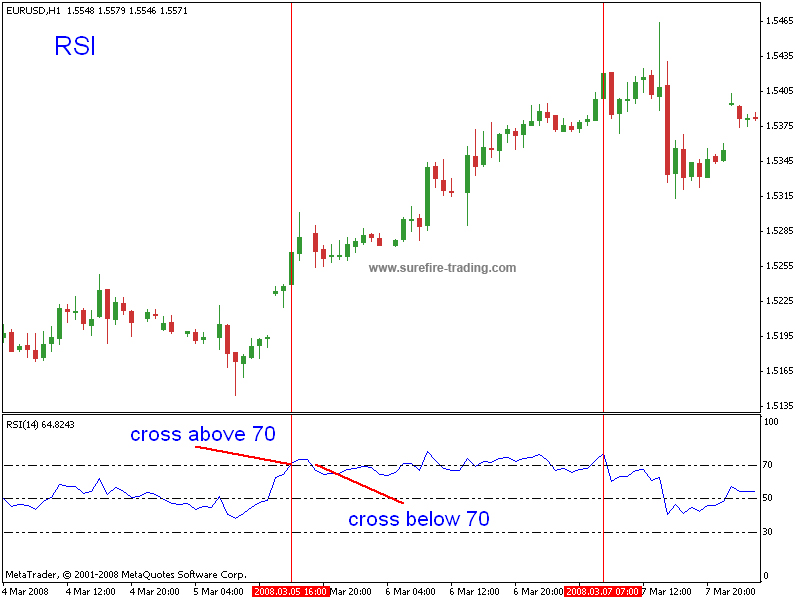
If you are trading Forex (e-minis), a 167 pip correction in the market is not a terrible risk, however, if you are trading Currency Futures (at $12.50/tic/contract), a 167 tic correction could be costly if the market does not follow through.
Taking another look at this same chart (below), we see that the Euro continued to fail in its attempt to reverse for an additional 482 pips, providing a crushing blow to the bears totaling 649 pips before making a defined reversal – now, as a Futures trader, a mistake like that could unnecessarily deplete your trading account immensely.
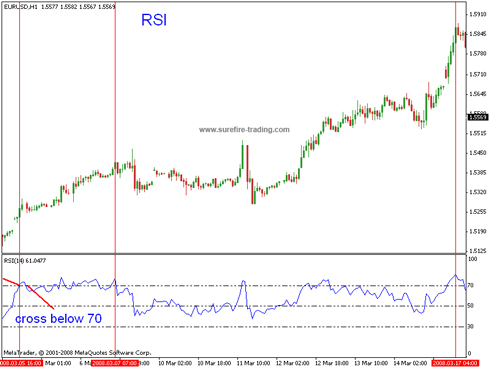
Right about now you may be thinking, “What are you trying to do, Ty, scare me?” Yes, I am. This is a business – it is not a game. If you want a game, go to the casino. My purpose is to provide you with a healthy respect for the markets. And provide you with the tools needed to succeed in this business. If you disrespect the markets by means of ignorance, laziness, or a basic “nonchalant” attitude, this beast will chew you up, swallow you whole - and not even choke………………and sleep like a baby when the bell rings.
To combat the fatal error depicted in the previous example there are a number of things that can be done. First and foremost, stay with the trend (which we will discuss later in this lesson). Second, practicing wise money management is a must; making sure your stops are in place. Also, using different settings like 80/20 can also be helpful. Experiment with the different settings and see which ones provide you with the greatest profits (and protection) for the particular time frame that you are trading.
Reversals and Retracements
Remember our definition of divergence; the price rising to a new high, whereas, the RSI makes a new low (bearish). Conversely, when price makes a new low, subsequently, the RSI makes a new high (bullish). Take note; the price trend line and the RSI trend line must be drawn relative to each other as depicted by the two vertical red lines. Remember – compare apples with apples.
In this 4-hr. chart, initially, we take notice of the fact that the price has indeed made a new high, as depicted by the upward sloping trend line (1) while the corresponding RSI trend line (2) is sloping downward indicating that the last RSI reading between the vertical red lines is lower than the initial RSI reading. This tells us that the bulls are weakening. What gives greater credibility to this sell signal is the fact that when the RSI pulled back (to the shaded area), it did not cross above the 70-line – it remained below the 70 level.
So, in summary, in the chart below, the price closed higher than the previous high, whereas, the RSI reversal signal began its formation above the 70 level and divergently moved to a position lower than the previous high.
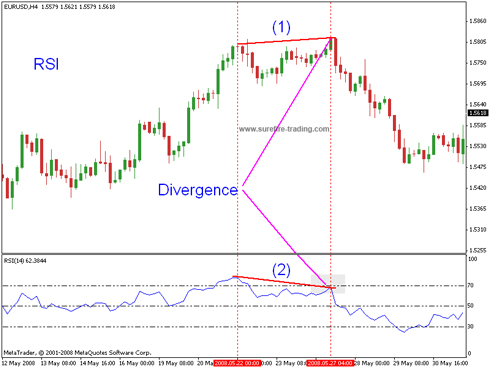
Once again, let’s look at the same chart where I have added trend lines (TL); two on the price chart and one to the RSI indicator. On the price chart, there is a primary TL and a secondary TL. The primary bullish TL designates the initial trend, however, we see that the price suddenly breaks away from the TL and moves aggressively in the same direction as the trend – providing us with a trend within a trend, designated by the secondary TL (and an opportunity for an early entry). The break to the bearish side of both the secondary TL on the price chart and a break to the bearish side of the RSI indicator provide us with additional confirmation that the bears are taking control.
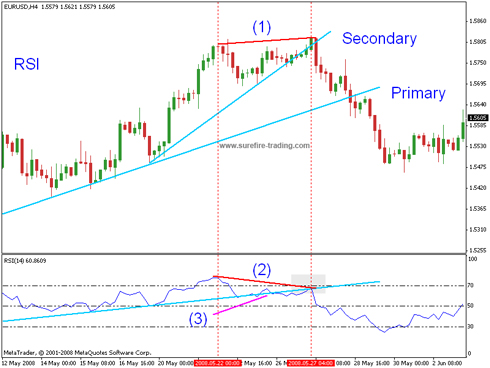
Trade Example
So, let’s take a look at some various ways we could trade this chart.
- First of all, price action is always my first concern and there is nothing that I like better that provides a visual perspective than the Bollinger Bands; so they are always on my charts.
- Secondly, I take notice that we have a classic Bollinger Band reversal signal indicating that the bulls may be losing control – so I look for confirmation.
- I receive the first confirmation with RSI divergence. Not completely satisfied – I wait for a second confirmation, which is provided to us with the trend line break and subsequent close.
- As candle (1) begins to fall, I take notice of the fact that the RSI (having broken the RSI trend line to the bearish side) has pulled back to the shaded area without crossing above the RSI trend line.
- As an aggressive trader, I would then place a Sell/Stop order (“sell at the market” if the price action is moving too swiftly) at the low of candle (2). A conservative entry would have been placed at the low of candles (3) or (4).
- With a close outside the lower Bollinger Band, I have confidence that the bears are in control so, as candle (5) retraced to the trend line (take note that a candle (5) entry only has credibility because of a price close below the lower band and the RSI has continued to fall below the 50-line) I would then add to my position.
- Immediately upon entering the market at any of the levels, my stop/loss would be placed a few pips above candle (1).
- With the subsequent BB reversal signal (candle formation 7), I begin to protect my profits with a trailing stop.
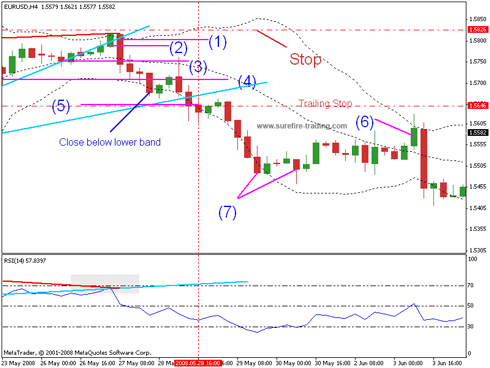
Trending Markets
We have just seen how the RSI and trend lines can help take advantage of a reversal or retracement opportunity.
But what about using the RSI in order to stay with the trend longer - “letting our profits run”?
Let’s take a look.
In the 4-hr. chart below, let’s assume we have entered the market at candle (1) with a bullish position on the break of the price trend line along with the break of the RSI trend line with a subsequent cross of the 50-line; we are long.
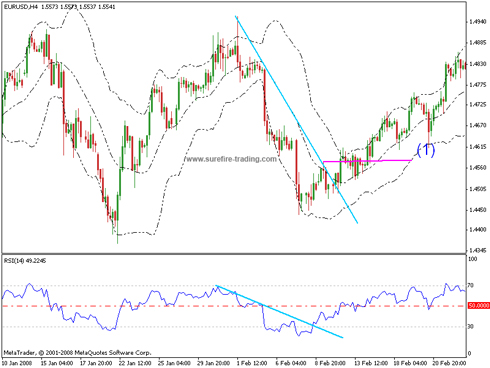
In the chart below, the Bollinger Bands provides confirmation to the price action as long as the price does not close below the lower band. Each time the market breaks the lower band (without a close) and returns upward, we protect our profits by moving our stops (red horizontal lines) to a position just below the candle that broke outside the band.
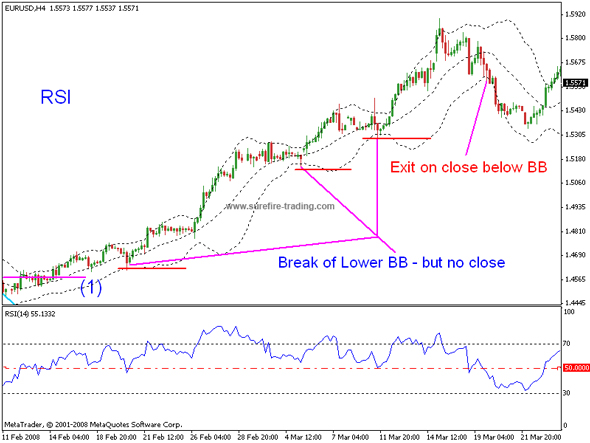
Added (or instead of the BB) confirmation is provided by the fact that the RSI (shaded area below) has predominantly remained above the 50-line at each retracement of the price. Each time the RSI moves toward the 50-line and subsequently returns to the 70 level, we move our stops to a position just below the candle that corresponds with the RSI in order to protect our profits – and remain in the market.
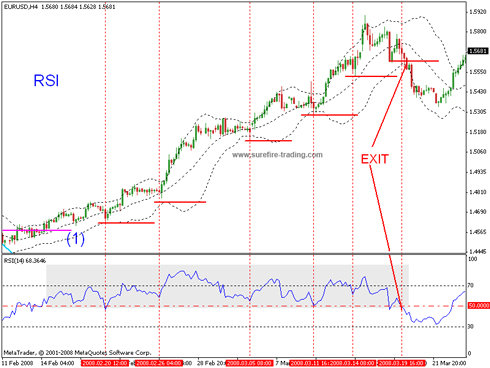
In this 4-hr. Euro chart, the close below the lower BB just happened to coincide with the break of the RSI 50-line (Good call).
More on Trending Markets
Let’s briefly discuss this concept of “trading the trend” in relationship to the RSI. Earlier I stated the time frame chosen varies with our different trading styles - or that which we are most comfortable. Primarily, this is determined by your personality and the size of your trading account. However, the chart that first provides us with an entry signal also determines what time frame we will trade. In other words, if we get a entry signal on the 60-min. chart, that’s the chart we trade; the 4-hr. chart, then the 4-hr. chart……and so forth.
In the previous 4-hr chart where I stated, “let’s assume we have entered the market at candle (1)”; let’s see why I chose that time frame? We had an entry signal - a break of the price trend line and a coinciding break of the RSI trend line. But how did I know that that break would have me “trading with the trend”? Take another look at the 4-hr. chart. From this chart (prior to the break upward), can you tell what the trend is?
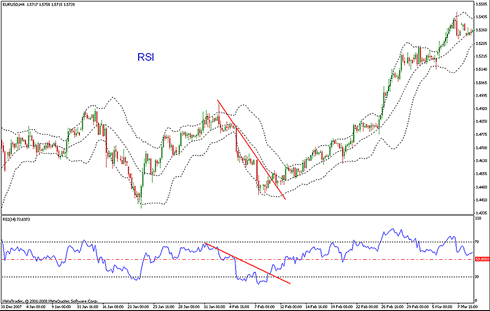
Of course not. But if I move up a time frame to a Daily chart, what do you see?
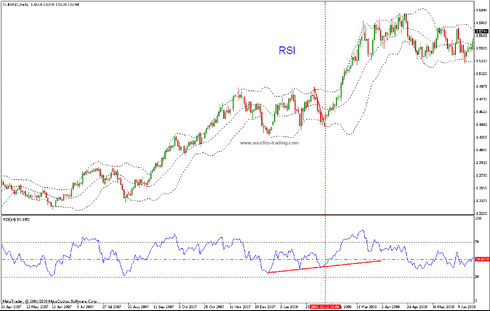
Not only do we have an obvious visual confirmation to the price trend but also we see that within the RSI each low is higher than the previous low – and heading toward the 50-line. My entry on the 4-hr chart was in-line with the trend on the Daily chart. Let’s look at another chart.
In the 15-min. chart below, we have a TL break and subsequent close and a RSI break, which takes it above the 50-line. Bullish right? But am I really entering with the trend? Frankly, we can’t tell from this chart either, can we?
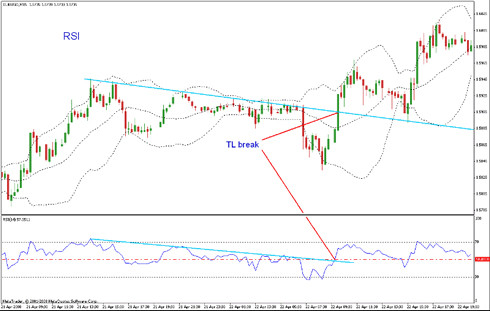
But if I go up to a 30-min. chart……now what do you see?
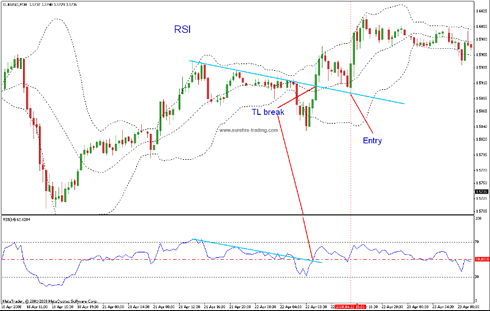
The 30-min chart shows us that we are indeed with the greater trend – while at the same time, the RSI is heading for bullish territory. I can enter on the long side on the pullback to the price TL because the RSI is still above the 50-line and heading north.
OK, one more example.
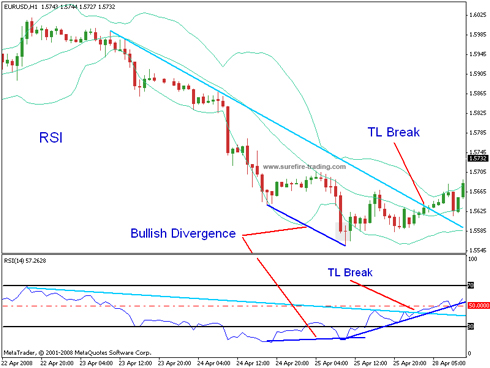
In this 1-hr. chart above we have a classic BB reversal signal, a nice little reversal doji (shaded area – but that’s for later), bullish divergence, and a trend line break on the price chart coinciding with a RSI trend line break and a RSI that has multiple higher lows. Awesome confirmation – what more can a trader ask for!!! I am so ready to jump in on the bullish side. But wait – let’s take a peek before we leap - at the 4-hr. chart…..….. :o)
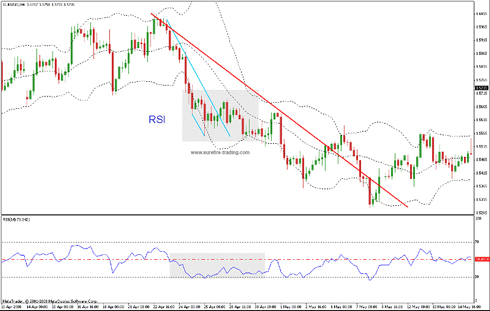
You still want to enter the market with a long order? I think not. Stay with the trend - stay within your comfort zone; take a step up one time frame and get the bigger picture.
Breakouts
Up till now we have primarily been dealing with trending markets. Someone asked me the other day, “What about “range-bound” markets? Well, let’s take a short look at a range-bound market. You will find that many of the guidelines given so far (including those which apply to the Bollinger Bands) still apply; i.e., BB Reversals & Trend continuation, divergence, and trend line breaks. However, here’s a small tidbit to add to your toolbox, which can offer us greater confidence in either continuing with the trade or making an initial entry.
Looking at the 4-hr. chart below there is an apparent range-bound market, which had continued for several months with a subsequent breakout to the bullish side. Was there a signal that was definable at that breakout?
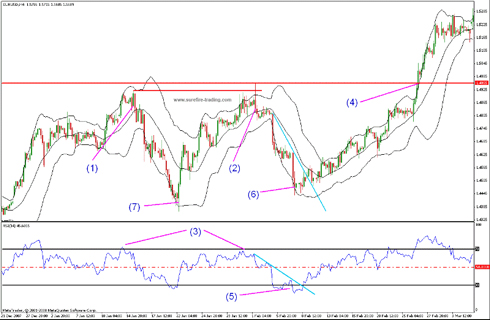
In order to answer this question, let’s look at a previous break of the high. Candle (2) broke higher than candle (1). Many would have been quick to have a “buy/stop” order waiting at the break of candle (1) merely because it is an area of resistance -only to have a failed trade – why? What is the RSI (3) formation called? Divergence. Not a good place to buy. However, when candle (4) broke higher than candle (2) at the same area of resistance, what did the RSI do? It broke above the 70 level….BINGO!
A nice place to buy. And confirmed by a close outside the upper BB – giving us a nice conservative trade.
However, being an aggressive trader, when RSI (5) broke below the 30 level with the coinciding candle (6) failing to break the previous low (7), I would have been looking for an opportunity to go long. Which I would have found as the RSI and price broke the coinciding trend lines – 459 pips earlier than entry (4).
Well, there you have it. There are other aspects of the RSI that are not within the limitations of this lesson but as you gain experience with the Relative Strength Index, you will begin to notice chart formations and support and resistance levels within the RSI that may not appear on the price chart – increasing the RSI’s potential.
With Surefire-trading.com, this is Ty Young, reminding you to “Read the Charts”. :o)
Ty Young
surefire-trading.com
0 comments:
